ignition DATSUN 610 1969 User Guide
[x] Cancel search | Manufacturer: DATSUN, Model Year: 1969, Model line: 610, Model: DATSUN 610 1969Pages: 171, PDF Size: 10.63 MB
Page 110 of 171
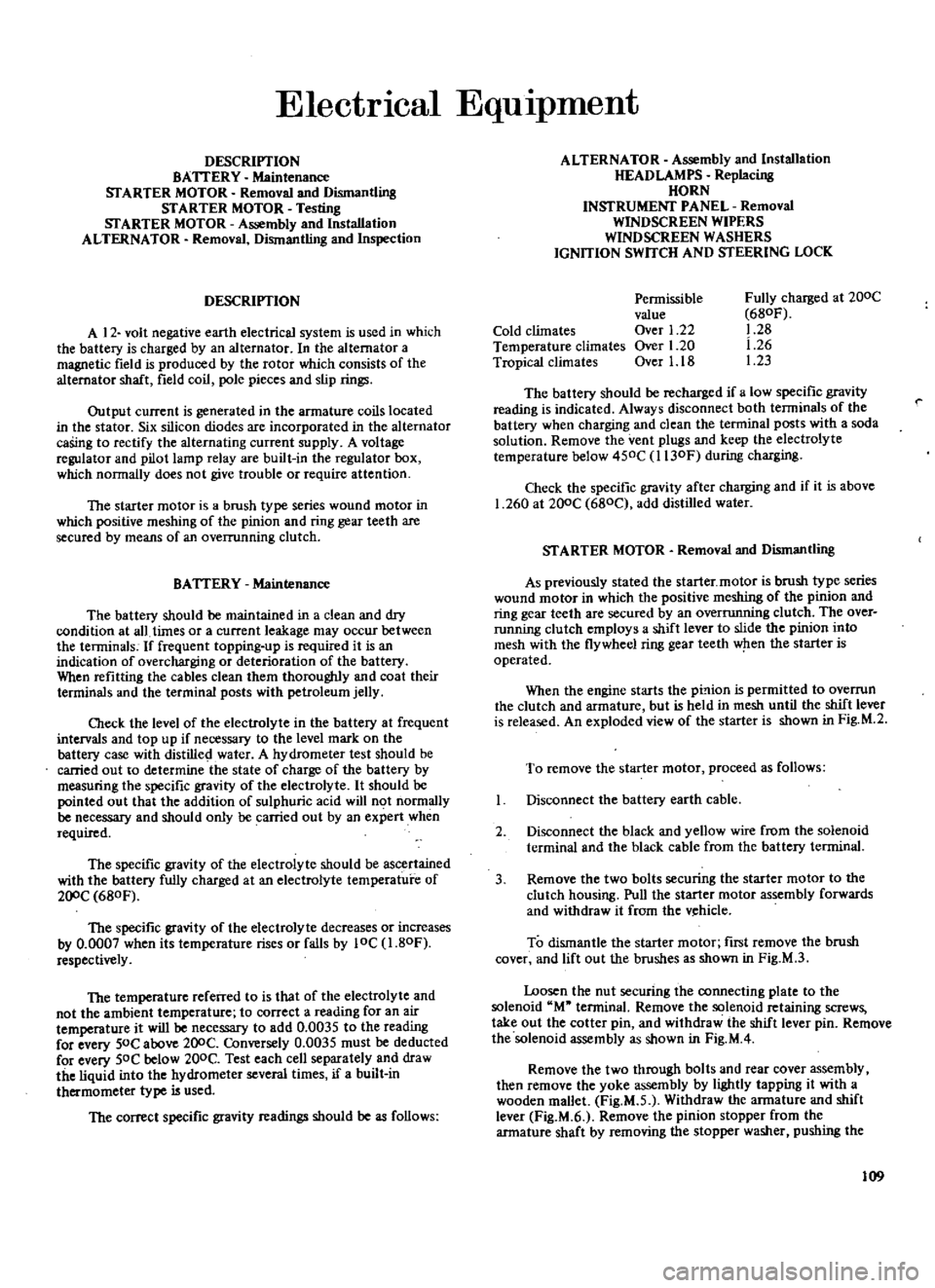
ElectrIcal
EquIpment
DESCRIPTION
BATTERY
Maintenance
STARTER
MOTOR
Removal
and
Dismantling
STARTER
MOTOR
Testing
STARTER
MOTOR
Assembly
and
Installation
ALTERNATOR
Removal
Dismantling
and
Inspection
DESCRIPTION
A
12
volt
negative
earth
electrical
system
is
used
in
which
the
battery
is
charged
by
an
alternator
In
the
alternator
a
magnetic
field
is
produced
by
the
rotor
which
consists
of
the
alternator
shaft
field
coil
p
le
pieces
and
slip
rings
Output
current
is
generated
in
the
armature
coils
located
in
the
stator
Six
silicon
diodes
are
incorporated
in
the
alternator
caSing
to
rectify
the
alternating
current
supply
A
voltage
regulator
and
pilot
lamp
relay
are
built
in
the
regulator
box
which
nonnally
does
not
give
trouble
or
require
attention
The
starter
motor
is
a
brush
type
series
wound
motor
in
which
positive
meshing
of
the
pinion
and
ring
gear
teeth
are
secured
by
means
of
an
overrunning
clutch
BATTERY
Maintenance
The
battery
should
be
maintained
in
a
clean
and
dry
condition
at
all
times
or
a
current
leakage
may
occur
between
the
terminals
If
frequent
topping
up
is
required
it
is
an
indication
of
overcharging
or
deterioration
of
the
battery
When
refitting
the
cables
clean
them
thoroughly
and
coat
their
terminals
and
the
terminal
posts
with
petroleum
jelly
Check
the
level
of
the
electrolyte
in
the
battery
at
frequent
intervals
and
top
up
if
necessary
to
the
level
mark
on
the
battery
case
with
distilled
water
A
hydrometer
test
should
be
carried
out
to
determine
the
state
of
charge
of
the
battery
by
measuring
the
specific
gravity
of
the
electrolyte
It
should
be
pointed
out
that
the
addition
of
sulphuric
acid
will
not
normally
be
necessary
and
should
only
be
carried
out
by
an
expert
when
required
The
specific
gravity
of
the
electrolyte
should
be
ascertained
with
the
battery
fully
charged
at
an
electrolyte
temperature
of
200C
680F
The
specific
gravity
of
the
electrolyte
decreases
or
increases
by
0
0007
when
its
temperature
rises
or
falls
by
10C
1
80F
respectively
The
temperature
referred
to
is
that
of
the
electrolyte
and
not
the
ambient
temperature
to
correct
a
reading
for
an
air
temperature
it
will
be
necessary
to
add
0
0035
to
the
reading
for
every
50C
above
200C
Conversely
0
0035
must
be
deducted
for
every
SOC
below
200C
Test
each
cell
separately
and
draw
the
liquid
into
the
hydrometer
several
times
if
a
built
in
thermometer
type
is
used
The
correct
specific
gravity
readings
should
be
as
follows
ALTERNATOR
Assembly
and
Installation
HEAD
LAMPS
Replacing
HORN
INSTRUMENT
PANEL
Removal
WINDSCREEN
WIPERS
WINDSCREEN
WASHERS
IGNITION
SWITCH
AND
STEERING
LOCK
Cold
climates
Temperature
climates
Tropical
climates
Permissible
value
Over
1
22
Over
1
20
Over
1
18
Fully
charged
at
200C
680F
1
28
1
26
1
23
The
battery
should
be
recharged
if
a
low
specific
gravity
reading
is
indicated
Always
disconnect
both
terminals
of
the
battery
when
charging
and
clean
the
terminal
posts
with
a
soda
solution
Remove
the
vent
plugs
and
keep
the
electrolyte
temperature
below
450C
l130F
during
charging
Check
the
specific
gravity
after
charging
and
if
it
is
above
1
260
at
200C
680C
add
distilled
water
STARTER
MOTOR
Removal
and
Dismantling
As
previously
stated
the
starter
motor
is
brush
type
series
wound
motor
in
which
the
positive
meshing
of
the
pinion
and
ring
gear
teeth
are
secured
by
an
overrunning
clutch
The
over
running
clutch
employs
a
shift
lever
to
slide
the
pinion
into
mesh
with
the
flywheel
ring
gear
teeth
when
the
starter
is
operated
When
the
engine
starts
the
pL
lion
is
permitted
to
overrun
the
clutch
and
armature
but
is
held
in
mesh
until
the
shift
lever
is
released
An
exploded
view
of
the
starter
is
shown
in
Fig
M
2
To
remove
the
starter
motor
proceed
as
follows
Disconnect
the
battery
earth
cable
2
Disconnect
the
black
and
yellow
wire
from
the
solenoid
terminal
and
the
black
cable
from
the
battery
terminal
3
Remove
the
two
bolts
securing
the
starter
motor
to
the
clutch
housing
Pull
the
starter
motor
assembly
forwards
and
withdraw
it
from
the
v
hicle
To
dismantle
the
starter
motor
ftrst
remove
the
brush
cover
and
lift
out
the
brushes
as
shown
in
Fig
M
3
Loosen
the
nut
securing
the
connecting
plate
to
the
solenoid
M
terminal
Remove
the
solenoid
retaining
screws
take
out
the
cotter
pin
and
withdraw
the
shift
lever
pin
Remove
the
solenoid
assembly
as
shown
in
Fig
M
4
Remove
the
two
through
bolts
and
rear
cover
assembly
then
remove
the
yoke
assembly
by
lightly
tapping
it
with
a
wooden
mallet
Fig
M
S
Withdraw
the
armature
and
shift
lever
Fig
M
6
Remove
the
pinion
stopper
from
the
armature
shaft
by
removing
the
stopper
washer
pushing
the
109
Page 117 of 171
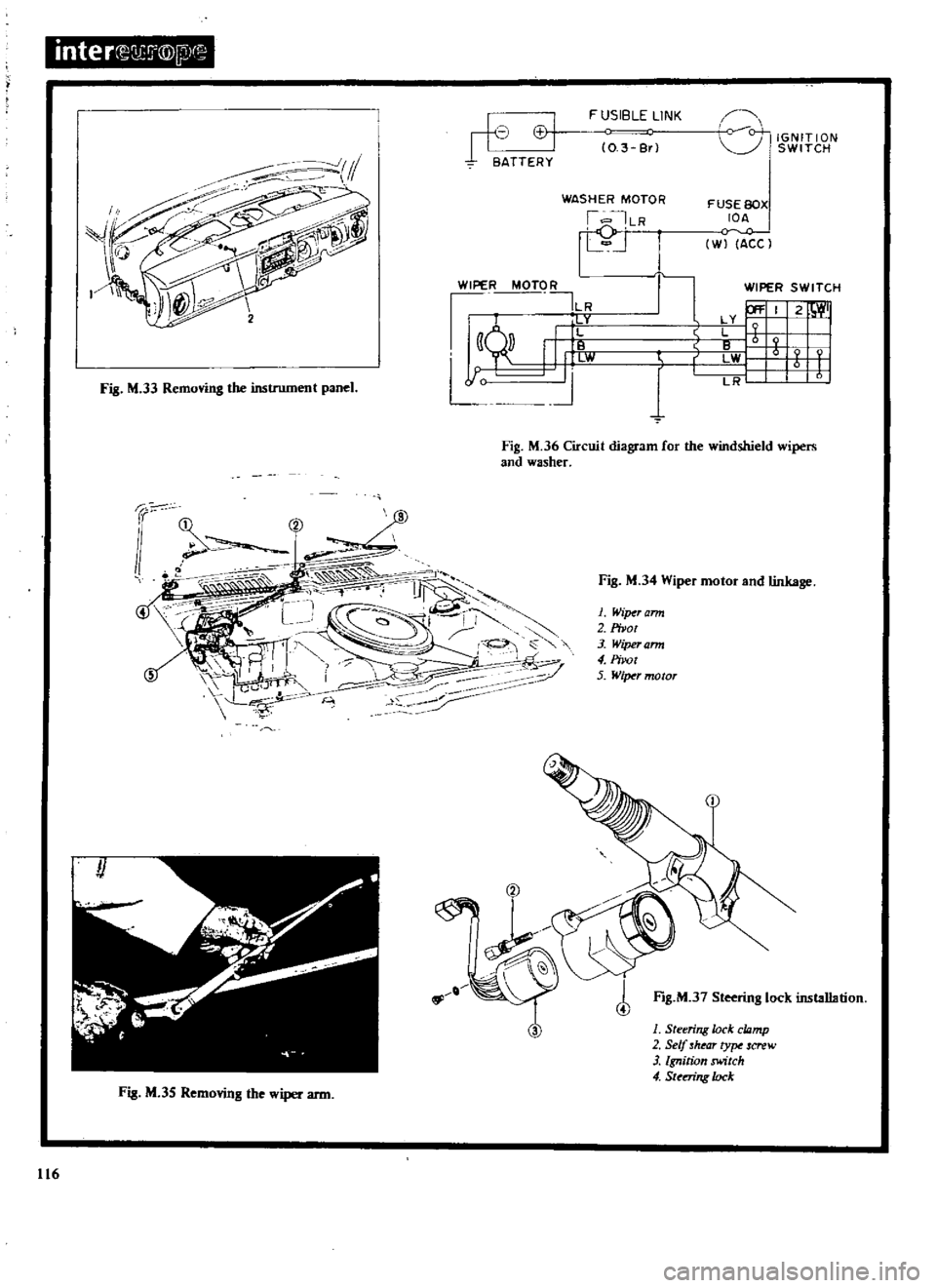
inter
@IP
Fig
M
33
Removing
the
instrument
panel
h
J
I
II
VI
BATTERY
FUSIBLE
LINK
0
3
Br
WASHER
MOTOR
I
ILR
rj
WIPER
MOTO
R
ILR
lity
111
W
J
9P
l
l
0
0
IGNITION
SWITCH
FUSE
BOX
IDA
0
W
ACC
r
WIPER
SWITCH
P
I
2
W
I
X
9
LWI
t
j
LR
Fig
M
36
Circuit
diagram
for
the
windshield
wipers
and
washer
Fig
M
35
Removing
the
wiper
arm
116
Fig
M
34
Wiper
motor
and
linkage
1
Wiper
arm
2
Pivot
3
Wiper
ann
4
Pirot
5
WiTNr
motor
f
Fig
M
37
Steering
lock
installation
1
Steering
lode
cwmp
2
Self
hear
ty
screw
3
Ignition
switch
4
SUmng
lock
Page 118 of 171
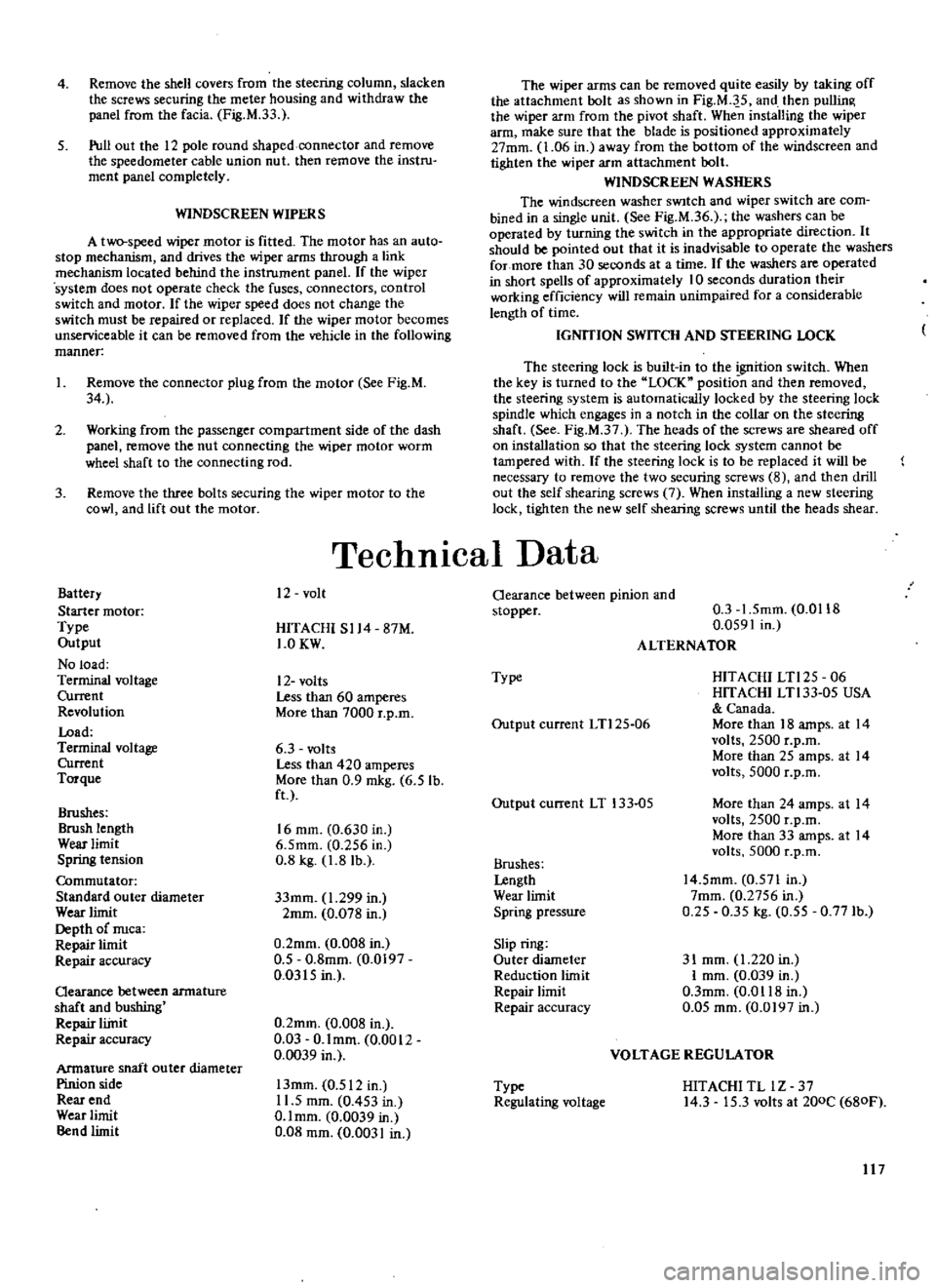
4
Remove
the
shell
covers
from
the
steering
column
slacken
the
screws
securing
the
meter
housing
and
withdraw
the
panel
from
the
facia
Fig
M
33
5
Pull
out
the
12
pole
round
shaped
connector
and
remove
the
speedometer
cable
union
nut
then
remove
the
instru
ment
panel
completely
WINDSCREEN
WIPERS
A
two
speed
wiper
motor
is
fitted
The
motor
has
an
auto
stop
mechanism
and
drives
the
wiper
arms
through
a
link
mechanism
located
behind
the
instrument
panel
If
the
wiper
system
does
not
operate
check
the
fuses
connectors
control
switch
and
motor
If
the
wiper
speed
does
not
change
the
switch
must
be
repaired
or
replaced
If
the
wiper
motor
becomes
unserviceable
it
can
be
removed
from
the
vehicle
in
the
fOllowing
manner
I
Remove
the
connector
plug
from
the
motor
See
Fig
M
34
2
Working
from
the
passenger
compartment
side
of
the
dash
panel
remove
the
nut
connecting
the
wiper
motor
worm
wheel
shaft
to
the
connecting
rod
3
Remove
the
three
bolts
securing
the
wiper
motor
to
the
cowl
and
lift
out
the
motor
Battery
Starter
motor
Type
Output
No
load
Terminal
voltage
Current
Revolution
Load
Terminal
voltage
Current
Torque
Brushes
Brush
length
Wear
limit
Spring
tension
Commutator
Standard
outer
diameter
Wear
limit
Depth
of
nuca
Repair
limit
Repair
accuracy
Qearance
between
armature
shaft
and
bushing
Repair
liinit
Repair
accuracy
Armature
shaft
ou
ter
diameter
Pinion
side
Rear
end
Wear
limit
Bend
limit
The
wiper
arms
can
be
removed
quite
easily
by
taking
off
the
attachment
bolt
as
shown
in
Fig
M
J
5
and
then
pullin
the
wiper
arm
from
the
pivot
shaft
When
installing
the
wiper
arm
make
sure
that
the
blade
is
positioned
approximately
27mm
1
06
in
away
from
the
bottom
of
the
windscreen
and
tighten
the
wiper
arm
attachment
bolt
WINDSCREEN
WASHERS
The
windscreen
washer
SWItch
and
wiper
switch
are
com
bined
in
a
single
unit
See
Fig
M
36
the
washers
can
be
operated
by
turning
the
switch
in
the
appropriate
direction
It
should
be
pointed
out
that
it
is
inadvisable
to
operate
the
washers
for
more
than
30
seconds
at
a
time
If
the
washers
are
operated
in
short
spells
of
approximately
10
seconds
duration
their
working
efficiency
will
remain
unimpaired
for
a
considerable
length
of
time
IGNITION
SWITCH
AND
STEERING
LOCK
The
steering
lock
is
built
in
to
the
goition
switch
When
the
key
is
turned
to
the
LOCK
position
and
then
removed
the
steering
system
is
automatically
locked
by
the
steering
lock
spindle
which
engages
in
a
notch
in
the
collar
on
the
steering
shaft
See
Fig
M
37
The
heads
of
the
screws
are
sheared
off
on
installation
so
that
the
steering
lock
system
cannot
be
tampered
with
If
the
steering
lock
is
to
be
replaced
it
will
be
necessary
to
remove
the
two
securing
screws
8
and
then
drill
out
the
self
shearing
screws
7
When
installing
a
new
steering
lock
tighten
the
new
self
shearing
screws
until
the
heads
shear
TechnICal
Data
12
volt
HITACHI
S114
87M
1
0KW
12
volts
Less
than
60
amperes
More
than
7000
r
p
m
6
3
volts
Less
than
420
amperes
More
than
0
9
mkg
6
5
lb
ft
16
mm
0
630
in
6
5mm
0
256
in
0
8
kg
1
8
lb
33mm
1
299
in
2mm
0
078
in
0
2mm
0
008
in
0
5
0
8mm
0
0197
0
0315
in
0
2mm
0
008
in
0
03
O
lmm
0
0012
0
0039
in
13mm
0
512
in
11
5
mm
0
453
in
O
lmm
0
0039
in
0
08
mm
0
0031
in
Oearance
between
pinion
and
stopper
0
3
1
5mm
0
0118
0
0591
in
ALTERNATOR
Type
HITACHI
LTl25
06
HITACHI
LTl33
05
USA
Canada
More
than
18
amps
at
14
volts
2500
r
p
m
More
than
25
amps
at
14
volts
5000
r
p
m
Output
current
LTl25
06
Output
current
LT
133
05
More
than
24
amps
at
14
volts
2500
r
p
m
More
than
33
amps
at
14
volts
5000
r
p
m
Brushes
Lengtb
Wear
limit
Spring
pressure
14
5mm
0
571
In
7mm
0
2756
in
0
25
0
35
kg
0
55
0
771b
Slip
ring
Outer
diameter
Reduction
limit
Repair
limit
Repair
accuracy
31
mm
1
220
in
I
mm
0
039
in
O
3mm
0
0118
in
0
05
mm
0
0197
in
VOLTAGE
REGULATOR
Type
Regulating
voltage
HITACHI
TL
lZ
37
14
3
15
3
volts
at
200C
680F
117
Page 126 of 171
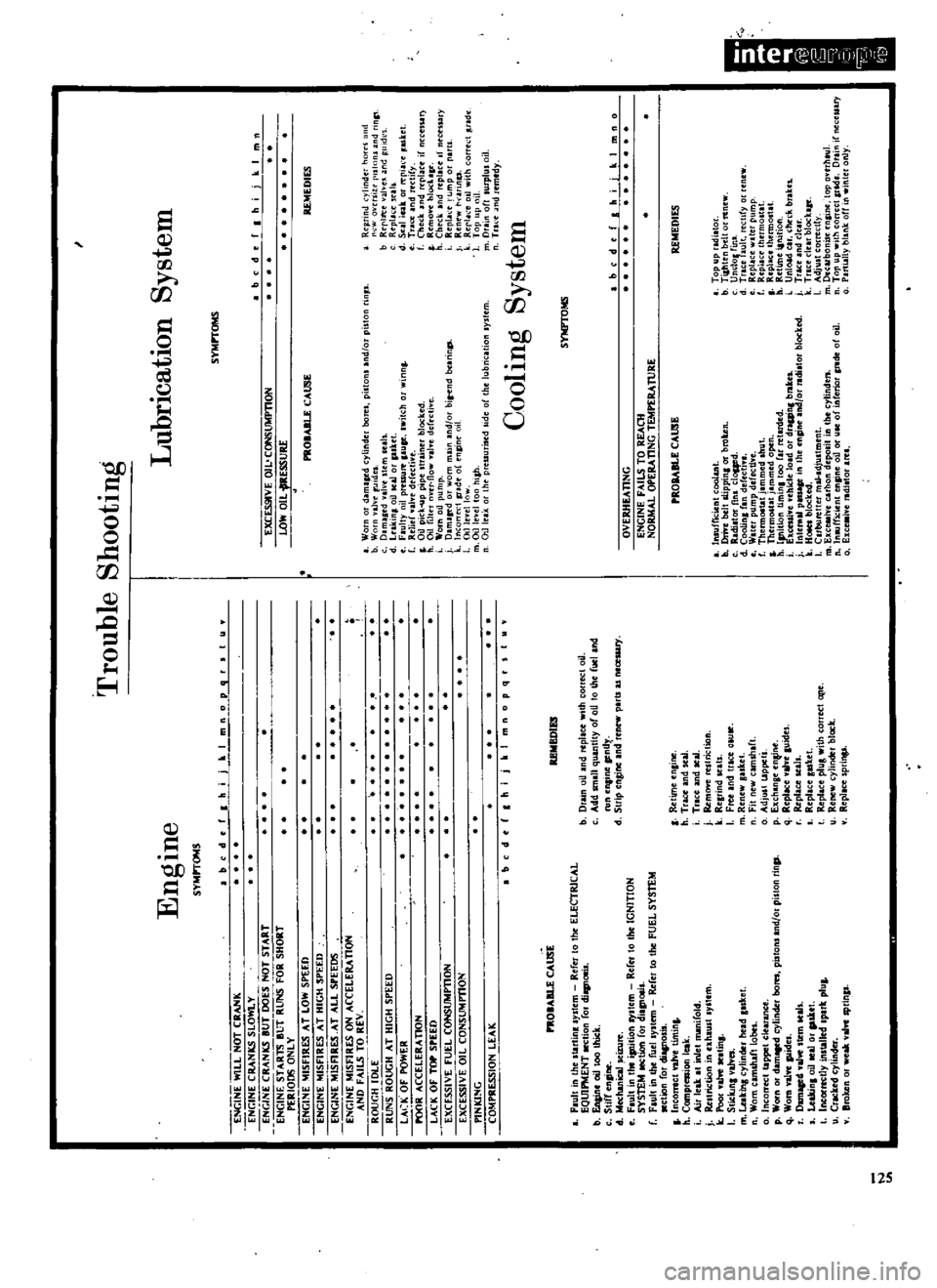
N
Engme
SYMPTOMS
I
Trouble
Shooting
Lubrication
System
SYMPTOMS
bed
t
f
I
h
i
1m
0
p
q
r
I
I
II
bed
t
f
I
h
Ii
I
m
n
ENGINE
WILL
NOT
CRANK
ENGINE
CRANKS
SLOWLY
ENGINE
CRANkS
BUT
OOES
NOT
START
ENGINE
STARTS
BUT
RUNS
FOR
SHORT
PERIODS
aNL
Y
ENGINE
I
tISFIRES
AT
LOW
SPEED
ENGINE
MISFIRES
AT
HIGH
SPEED
ENGINE
MISFIRES
AT
ALL
SPEEDS
ENGINE
MISFIRES
ON
ACCELERATION
AND
FAILS
TO
REV
ROUGH
IDLE
RUNS
ROUGH
AT
HIGH
SPEED
lACK
OF
POWER
POOR
CCElERA
nON
LACK
OF
TOP
SPEED
EXCESSIVE
FUEL
CONSUMmON
EXCESSIVE
OIL
CONSUMmON
PINKING
COMPRESSION
LEAK
PROIABLE
CAUSE
Faull
In
th
e
ltartinll
IYltem
Refer
to
the
ELECTRICAL
EQUIPMENT
leetion
fOI
dilllflOlIll
b
Eft
ineoiltoothick
Stiffenpne
d
Mechanieal
scimre
Flult
In
lhe
IpUlion
I
ltem
Refer
to
the
IGNITION
SYSTEM
IeCtion
for
di
I
f
Flult
the
fuellYlltm
Refer
to
the
FUEL
SYSTEM
Clion
or
di
l
OIII
Incomcl
tllvetlmln
h
ComprellllllIU
IClk
Air
leak
IRlel
JIlIIni
old
j
Reltriction
nhlu5t5ylltm
Ie
Poor
alYe
WIIIIIJ
I
Stick
tnlvall
n
m
Lclklnl
cylinder
held
Illke
Womcamlhlft
lobel
IncolTe
ttappetclurance
p
Worn
dlm
ed
cylinder
born
pUlon5
Ind
or
pll
f1np
q
Wom
nl
fC
paides
Damaced
a1wlttmseal
LeWnloilwaI
pu
e
Incorrectly
installed
apark
plu
CrICked
cylinder
Broken
weakv
w
sprinp
EXCES9lVE
OIL
CONSUMPTION
WW
OIL
ilRESSURE
PROIABLE
CAUSE
REMEDIES
I
Worn
dlmalJl
dcyhnderbon
P
v
lnd
orpulu
nnr
s
b
WorJl
valve
r
uides
C
D
m
led
valve
lIemluls
d
Lnlunr
oil
ul
pillet
e
Flulty
nil
P
uu
IluP
Iwnch
wmn
f
Relief
valve
defecuve
011
pick
up
pipellfline
blocked
h
011
filler
nver
flow
yaJYe
dcffe
WO
n
oil
pump
J
Dlmllfd
om
maUl
Ind
or
bl
nd
b
lnnll
l
lncorreCllndeofentpneoil
l
Oil
level
10
m
Oillevel
tnnhllh
Oillelk
the
preuunled
Ilde
of
the
lubn
IYSfem
p
Tldc
Rel1
f1nd
yllOde1
ne
OVCntZl
nd
nnJ
b
Rcpltte
v
lve
and
Iltd
c
Repl
cc
5c
l
d
Sullu
rt
pl
cp
aI
kCl
e
Trice
Ind
rtClify
f
heel
lod
replace
if
nccess
T
RemoYcblQChJC
h
Chcck
Ind
repllcclfncct
i
ry
i
Repll
e
rump
J
Renew
nnp
k
Rerl
ec
OIl
with
l
Top
up
oil
m
DTllnofllurpIUloil
Tn
ndremedy
Coolmg
System
b
r
h
j
I
m
p
q
d
REMEDIES
SYMI
IOMS
b
Drlm
oiJ
nd
rcpl
ce
with
ot
Add
smlll
quanllty
n
oil
to
the
fuel
Ind
rune
lmeFnd
d
SlfIpenJine
Ind
renew
p
ru
asn
celllry
I
bed
t
f
I
h
I
i
k
I
mn
0
OVERHEATING
ENGINE
FAILS
TO
REAOI
NORMAL
OPERATING
TEMPERAt
lRE
PROIAILE
CAUSE
REMEDIES
I
RetUne
enJine
h
Trace
ndseal
Tr
Ind
seal
j
RemO
f
t
rellnction
k
Relnnd
sel
I
Freelnd
trice
C
UIe
m
Renewguke
Fit
new
clmlhlrt
AdJult
t
appeti
p
bch
ngeenfin
q
Replacevalnluldes
Rtplace
seall
Repllccgukel
Repllcc
plulwlth
correct
Cl
Ie
Renew
cyhndcrblock
Repllce
5prLnp
I
IlIIIIfficien
coolant
b
DriYebellllippinIOfbrobn
c
RldiatOf
fUll
cloq
ed
d
Coo
inlflndefeclln
e
Wit
pl1mpdtfectlve
f
ThelTllOllatj
mmed
Ihul
Thermost
j
mmed
open
r
t
eti
I
kt
r
re
a
q
brake
j
lntel1laJp
se
lheenpne
ndforradi
torbloeked
11
HOItI
blocked
I
Carburetterm
djullmem
m
Excellive
arbon
depolit
in
thecylinden
In
ffici
enpneoil
uae
of
inferior
p1Ide
of
oil
Exce
inrldi
lorlrea
I
Topupradil
v
b
Ti
htenbdtorftnc
I
t
rmify
e
Repl
cwaterpump
f
Rcpll
e
thermoltll
I
Replleclhermolt
t
h
RetimeiaTUlion
i
Unload
ear
check
brl
ktt
j
Trace
ndclu
k
TfI
cdUrblockaae
L
AdjUllcorrc
cth
m
Decarbonise
fO
tne
top
overh
uJ
Top
up
wlth
correct
rade
Dr
inifneceUlry
PUIl
lly
blink
off
in
winter
only
Page 127 of 171
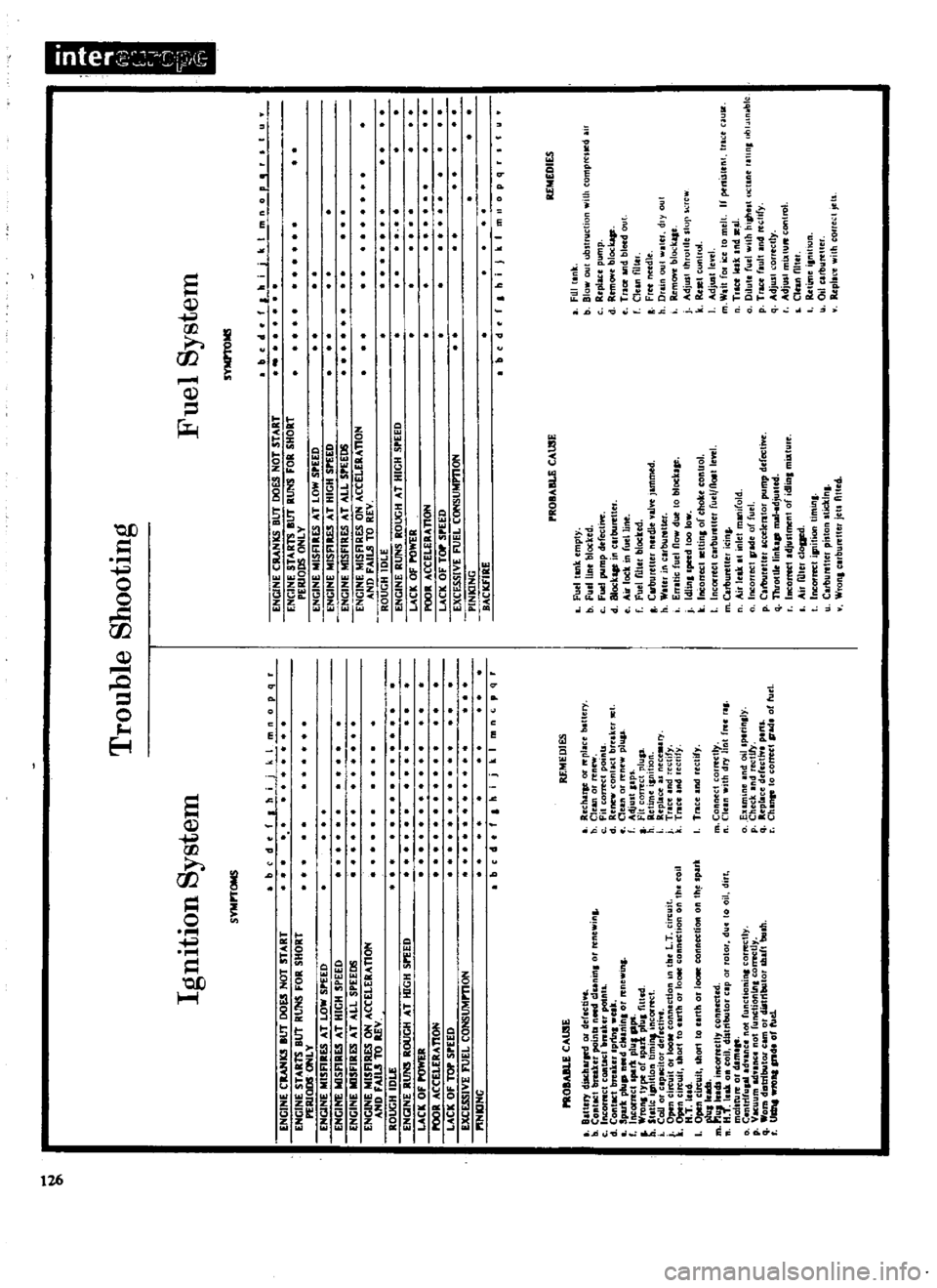
Trouble
Shooting
Ignition
System
SYMnONS
be
d
t
f
I
h
ENGINE
CRANKS
IUT
DOES
NOT
nART
ENGINE
STARTS
BUT
RUNS
FOR
SHORT
PERIODS
ONLY
ENGINE
MISfiRES
AT
LOW
SPEED
ENCINE
WlSflRES
AT
HIGH
SPEED
ENGINE
MISFIRES
AT
ALL
SPEEDS
ENCINE
MISfiRES
ON
ACCELERATION
AND
FAI
TO
REV
ROUGH
IDLE
ENGINE
RUNS
ROUCH
AT
toGH
SPEED
UCK
OF
POWER
POOR
ACCELERAnON
LACK
OF
TOP
SPEED
EXCESSIVE
FUEL
CONSUMmON
PlNKlNC
PROBABLE
CAU5E
t
Bani
dilcharFd
01
defective
b
COJlIllCl
nabr
poinb
nCiCCl
c1Unlftl
renewlna
c
Incorrect
cantlel
ltn
ktr
potftu
d
ConllCt
maker
Iprtn
wuk
Spark
plup
n
d
ch
ntnl
nnewlJIl
r
Jncorrec
llpulpl1llPpI
WronllypeoCap
rtpllllflttad
h
Slltlc
I
lllon
limina
Incorrect
I
Coli
c
plCilor
defC
tl
t
g
o
o
c
o
c
t1o
t
n
h
CllIl
the
toil
H
T
lud
I
Open
cimail
lIlort
nnh
1
conneclion
Ih
spart
m
l
1ulludslnCClfRcllyc
oIIJlCC
tcd
H
T
Ink
coil
dbtribulor
elp
due
oil
din
mol
t
I
o
d
ml
C
ntrlfuplld
anee
not
unetionln
eOll
lctly
p
VKuum
Id
e
not
funclionill
cOIYKtly
q
om
datrlbutw
elm
Or
4iltributor
dldt
bluh
I
UllntWJlOlllpldl
off
ld
L
i
k
I
m
no
p
q
I
b
m
q
f
h
i
j
REMEDIES
I
aceh
tJe
oc
pllce
blHery
b
Clean
01
n
c
Fi
wrrecl
poin
d
Renew
blnker
ll
t
Clea
l
l
ne
plllll
f
Adjull
pt
Fit
cor
c
plu
l
h
aetUne
i
mtlon
I
a
plaCf
I
nece
r
j
Trice
Ind
recury
k
True
ndlecfity
Tnee
nd
leclity
m
Con
c
cOI
ct1r
Clca
wIth
dry
hn
fne
rl
EllImlne
and
Oillpllln
ly
p
Cheek
Ind
rectlly
q
aepllccddectkol
plnl
r
Chlnp
comct
Il
adl
of
fuel
Fuel
System
ENGINE
CRANKS
8lTf
DOES
NOT
START
ENGINE
STARTS
BUT
RUNS
FOR
SHORT
PERIODS
ONLY
ENGINE
MISARES
AT
LOW
SPEED
ENGINE
MISflRE5
AT
HIGH
SPEED
ENGINE
MISFIRES
AT
ALL
SPEEDS
ENGINE
MISAKES
ON
ACCELERA110N
AND
FAILS
TO
REV
ROUGH
IDLE
ENGINE
RUNS
ROUGH
AT
HIGH
SPEED
LACK
OF
POWER
POOR
ACCELERA110N
LACK
OF
TOP
SPEED
EXCESSIVE
flJEL
CONSUMmON
PINKING
BACKFIRE
PROBABLE
CAU5E
Fuel
tank
empty
b
Fu
llinc
blocked
Fuel
pumpd
fectiYe
d
Block
in
cllburene
Air
lock
in
fuel
line
f
Fuel
rut
r
blocked
I
Cuburetter
needle
nlve
jammed
h
Wile
CI
buRlt
r
Errltic
fllel
now
due
blocka
j
IdlinJlpeed
too
low
k
InConectlCtllnlofcttoke
conllol
1
lncorrectcarbuntterfuel
nOltlewl
m
C
muretler
Itlna
Ail
leak
It
Inlet
mlrurold
Incorrect
pade
offuet
p
Carburetter
accelerator
pumpdefect
e
q
Throlll
lintl
rrlIIl
djUlled
IncofftCl
Idjullmenl
of
IdlmJ
mutU
e
Aif
nltef
elogcd
Incorm
t
lpiitiOlluminJ
Clrburellel
Pll
un
lIitkln
Wron
cllburenerjetl
Atled
YMPtO
I
bell
f
1
h
I
j
k
I
m
nOli
I
I
I
0
b
f
h
i
J
k
I
m
REMEDIES
q
FLllllnk
b
Blow
ObSIf1rCllUll
ilh
compl
t
lIed
R
pll
pump
d
RemO
l
e
blockaJe
Trace
Uld
bleed
QUI
r
CIUl1fi1tef
K
Fretne
dle
h
Drlln
d
yout
Removeblockq
J
Adju
throlllelfOl
k
Reset
conllol
1
AdjUSlle
e
m
Wlit
fOI
melt
If
pt
nLS
n
nu
Tlact
lelklndse
a1
Dllu
e
fuel
with
hlah
I
rllln
ubl
ln
blc
p
Trace
fault
and
reeufy
q
AdjuII
correelly
Adju
mutufWconlrol
Clnnnlttr
Retjme
Ilftn
OdClrbulelle
Repllce
Wllh
Je
Page 134 of 171
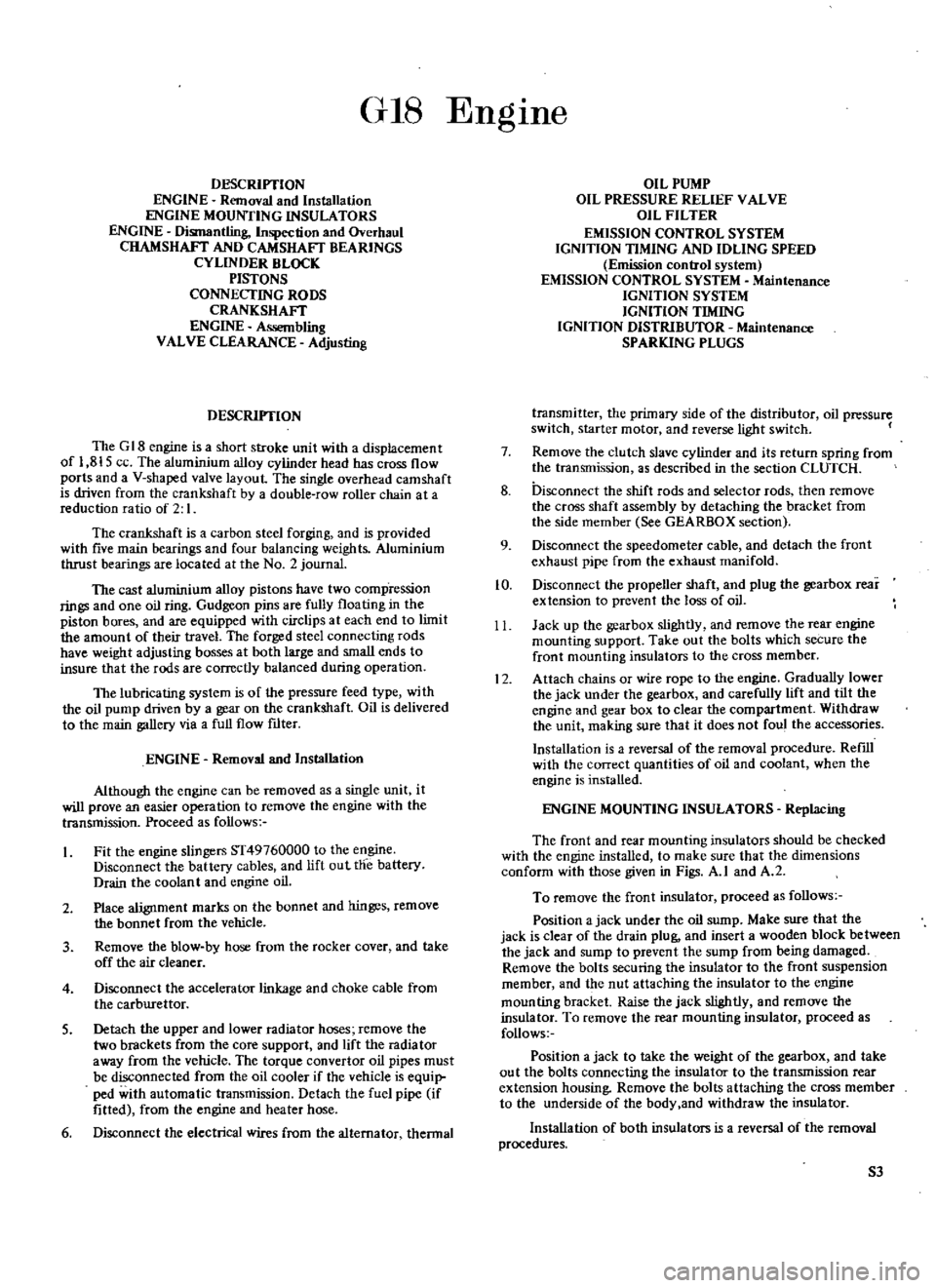
GIS
DESCRIYfION
ENGINE
Removal
and
Installation
ENGINE
MOUNTING
INSULATORS
ENGINE
Dismantling
Inspection
and
Overhaul
CHAMSHAFT
AND
CAMSHAFT
BEARINGS
CYLINDER
BLOCK
PISTONS
CONNECTING
RODS
CRANKSHAFT
ENGINE
Assembling
VALVE
CLEARANCE
Adjusting
DESCRIYfION
The
G
18
engine
is
a
short
stroke
unit
with
a
displacement
of
1
815
ce
The
aluminium
alloy
cylinder
head
has
cross
flow
ports
and
a
V
shaped
valve
layout
The
single
overhead
camshaft
is
driven
from
the
crankshaft
by
a
double
row
roller
chain
at
a
reduction
ratio
of
2
I
The
crankshaft
is
a
carbon
steel
forging
and
is
provided
with
five
main
bearings
and
four
balancing
weights
Aluminium
thrust
bearings
are
located
at
the
No
2
journal
The
cast
aluminium
alloy
pistons
have
two
comp
ression
rings
and
one
oil
ring
Gudgeon
pins
are
fully
floating
in
the
piston
bores
and
are
equipped
with
circlips
at
each
end
to
limit
the
amount
of
their
travel
The
forged
steel
connecting
rods
have
weight
adjusting
bosses
at
both
large
and
small
ends
to
insure
that
the
rods
are
correctly
balanced
during
operation
The
lubricating
system
is
of
the
pressure
feed
type
with
the
oil
pump
driven
by
a
gear
on
the
crankshaft
Oil
is
delivered
to
the
main
gallery
via
a
full
flow
ftlter
ENGINE
Removal
and
Installation
Although
the
engine
can
be
removed
as
a
single
unit
it
will
prove
an
easier
operation
to
remove
the
engine
with
the
transmission
Proceed
as
follows
Fit
the
engine
slingers
ST49760000
to
the
engine
Disconnect
the
battery
cables
and
lift
out
the
battery
Drain
the
coolant
and
engine
oil
2
Place
alignment
marks
on
the
bonnet
and
hinges
remove
the
bonnet
from
the
vehicle
3
Remove
the
blow
by
hose
from
the
rocker
cover
and
take
off
the
air
cleaner
4
Disconnect
the
accelerator
linkage
and
choke
cable
from
the
carburettor
S
Detach
the
upper
and
lower
radiator
hoses
remove
the
two
brackets
from
the
core
support
and
lift
the
radia
tor
away
from
the
vehicle
The
torque
convertor
oil
pipes
must
be
disconnected
from
the
oil
cooler
if
the
vehicle
is
equip
ped
with
automatic
transmission
Detach
the
fuel
pipe
if
fitted
from
the
engine
and
heater
hose
6
Disconnect
the
electrical
wires
from
the
alternator
thennal
EngIne
OIL
PUMP
OIL
PRESSURE
RELIEF
VALVE
OIL
FILTER
EMISSION
CONTROL
SYSTEM
IGNITION
TIMING
AND
IDLING
SPEED
Emission
control
system
EMISSION
CONTROL
SYSTEM
Maintenance
IGNITION
SYSTEM
IGNITION
TIMING
IGNITION
DISTRIBUTOR
Maintenance
SPARKING
PLUGS
transmitter
the
primary
side
of
the
distributor
oil
pressure
switch
starter
motor
and
reverse
light
switch
7
Remove
the
clutch
slave
cylinder
and
its
return
spring
from
the
transmission
as
described
in
the
section
CLUTCH
8
Disconnect
the
shift
rods
and
selector
rods
then
remove
the
cross
shaft
assembly
by
detaching
the
bracket
from
the
side
member
See
GEARBOX
section
9
Disconnect
the
speedometer
cable
and
detach
the
front
exhaust
pipe
from
the
exhaust
manifold
10
Disconnect
the
propeller
shaft
and
plug
the
gearbox
rear
extension
to
prevent
the
loss
of
oil
11
Jack
up
the
gearbox
slightly
and
remove
the
rear
engine
mounting
support
Take
out
the
bolts
which
secure
the
front
mounting
insulators
to
the
cross
member
12
Attach
chains
or
wire
rope
to
the
engine
Gradually
lower
the
jack
under
the
gearbox
and
carefully
lift
and
tilt
the
engine
and
gear
box
to
clear
the
compartment
Withdraw
the
unit
making
sure
that
it
does
not
foul
the
accessories
Installation
is
a
reversal
of
the
removal
procedure
RefIll
with
the
correct
quantities
of
oil
and
coolant
when
the
engine
is
installed
ENGINE
MOUNTING
INSULATORS
Replacing
The
front
and
rear
mounting
insulators
should
be
checked
with
the
engine
installed
to
make
sure
that
the
dimensions
conform
with
those
given
in
Figs
A
I
and
A
2
To
remove
the
front
insulator
proceed
as
follows
Position
a
jack
under
the
oil
sump
Make
sure
that
the
jack
is
clear
of
the
drain
plug
and
insert
a
wooden
block
between
the
jack
and
sump
to
prevent
the
sump
from
being
damaged
Remove
the
bolts
securing
the
insulator
to
the
front
suspension
member
and
the
nut
attaching
the
insulator
to
the
engine
mounting
bracket
Raise
the
jack
slightly
and
remove
the
insulator
To
remove
the
rear
mounting
insulator
proceed
as
follows
Position
a
jack
to
take
the
weight
of
the
gearbox
and
take
out
the
bolts
connecting
the
insulator
to
the
transmission
rear
extension
housing
Remove
the
bolts
attaching
the
cross
member
to
the
underside
of
the
body
and
withdraw
the
insulator
Installation
of
both
insulators
is
a
reversal
of
the
removal
procedures
S3
Page 137 of 171

inter
lliJ
i
@
j2J
c
Arrow
m
lrk
J
II
J
Fig
A
13
Installing
the
gudgeon
pin
circlip
Fig
A
12
Assembling
11
piston
and
connecting
rod
Fig
A
14
Installing
the
cylinder
block
oil
se
l
Apply
liquid
packing
he
e
Fig
A
IS
Rear
be
ring
cap
9
3
6
8
r
r
Q
i
ig
JtJl
f
it
I
1
f
l
O
2
1
lJ@O
j
0
i4i
Front
o
7
5
2
4
10
Fig
A
16
Connecting
rod
caps
and
lock
wIshers
Fig
A
18
Cylinder
head
boils
lightening
sequence
Fig
A
19
Imta1ling
the
ignition
distn1
utOT
note
the
position
of
rotOf
56
Fig
A
20
Tensioning
the
oil
pump
drive
dlain
Page 141 of 171

inter
lliJ
@
jll
Air
njection
noule
Air
gallery
pipe
Fig
A
24
Sectional
view
of
air
injection
nozzle
and
exhaust
port
J
I
F
J
Oil
pan
CarbUretor
ir
cleaner
I
7
Control
aln
Ialiable
orifice
alve
Fig
A
21
Section
through
the
pressure
relief
valve
DiIIchqe
w
Fig
A
22
Details
of
the
positive
crankcase
ventilation
system
I
Bal
Ifttrk
ion
orif
c
Fig
A
2S
Sectional
view
of
anti
backCue
valve
Fig
A
26
Adjusting
the
ignition
timing
and
idling
speed
mixture
emission
control
system
510
Page 142 of 171
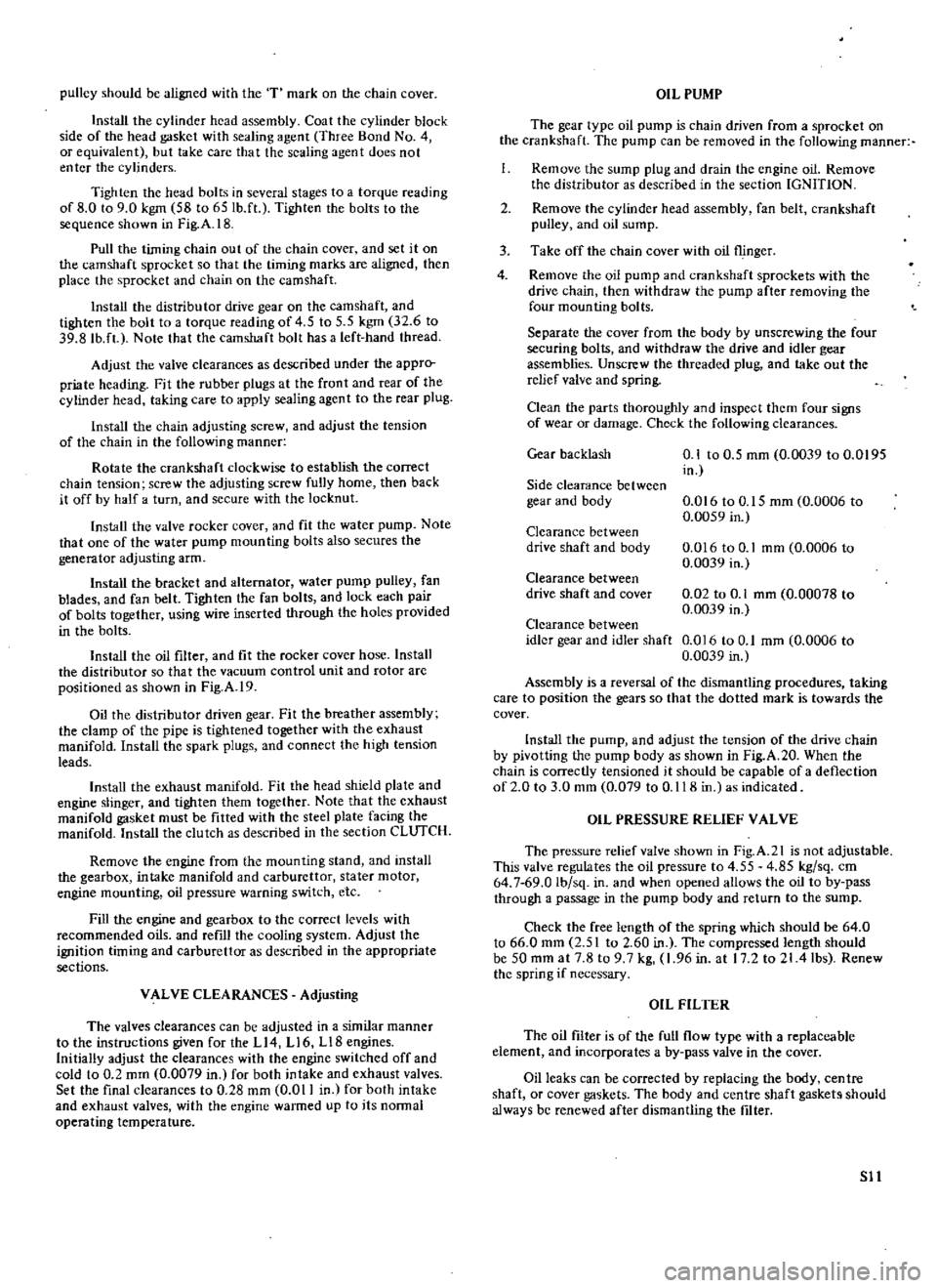
pulley
should
be
aligned
with
the
T
mark
on
the
chain
cover
Install
the
cylinder
head
assembly
Coat
the
cylinder
block
side
of
the
head
gasket
with
sealing
agent
Three
Bond
No
4
or
equivalent
but
take
care
that
the
scaling
agent
does
not
enter
the
cylinders
Tighten
the
head
bolts
in
several
stages
to
a
torque
reading
of
8
0
to
9
0
kgrn
58
to
65
lb
ft
Tighten
the
bolts
to
the
sequence
shown
in
Fig
A
IB
Pull
the
timing
chain
out
of
the
chain
cover
and
set
it
on
the
camshaft
sprocket
so
that
the
timing
marks
are
aligned
then
place
the
sprocket
and
chain
on
the
camshaft
Install
the
distributor
drive
gear
on
the
camshaft
and
tighten
the
bolt
to
a
torque
reading
of
4
5
to
5
5
kgrn
32
6
to
39
8
lb
ft
Note
that
the
camshaft
bolt
has
a
left
hand
thread
Adjust
the
valve
clearances
as
described
under
the
appro
priate
heading
Fit
the
rubber
plugs
at
the
front
and
rear
of
the
cylinder
head
taking
care
to
apply
sealing
agent
to
the
rear
plug
Install
the
chain
adjusting
screw
and
adjust
the
tension
of
the
chain
in
the
following
manner
Rotate
the
crankshaft
clockwise
to
establish
the
correct
chain
tension
screw
the
adjusting
screw
fully
home
then
back
it
off
by
half
a
turn
and
secure
with
the
locknut
Install
the
valve
rocker
cover
and
fit
the
water
pump
Note
that
one
of
the
water
pump
mounting
bolts
also
secures
the
generator
adjusting
arm
Install
the
bracket
and
alternator
water
pump
pulley
fan
blades
and
fan
belt
Tighten
the
fan
bolts
and
lock
each
pair
of
bolts
together
using
wire
inserted
through
the
holes
provided
in
the
bolts
Install
the
oil
filter
and
fit
the
rocker
cover
hose
Install
the
distributor
so
that
the
vacuum
control
unit
and
rotor
arc
positioned
as
shown
in
Fig
A
19
Oil
the
distributor
driven
gear
Fit
the
breather
assembly
the
clamp
of
the
pipe
is
tightened
together
with
the
exhaust
manifold
Install
the
spark
plugs
and
connect
the
high
tension
leads
Install
the
exhaust
manifold
Fit
the
head
shield
plate
and
engine
slinger
and
tighten
them
together
Note
that
the
exhaust
manifold
gasket
must
be
fitted
with
the
steel
plate
facing
the
manifold
Install
the
clutch
as
described
in
the
section
CLUTCH
Remove
the
engine
from
the
mounting
stand
and
install
the
gearbox
intake
manifold
and
carburettor
stater
motor
engine
mounting
oil
pressure
warning
switch
etc
Fill
the
engine
and
gearbox
to
the
correct
levels
with
recommended
oils
and
refill
the
cooling
system
Adjust
the
ignition
timing
and
carburettor
as
described
in
the
appropriate
sections
VALVE
CLEARANCES
Adjusting
The
valves
clearances
can
be
adjusted
in
a
similar
manner
to
the
instructions
given
for
the
L14
LI6
L18
engines
Initially
adjust
the
clearances
with
the
engine
switched
off
and
cold
to
0
2
mm
0
0079
in
for
both
intake
and
exhaust
valves
Set
the
final
clearances
to
0
28
mm
0
011
in
for
both
intake
and
exhaust
valves
with
the
engine
warmed
up
to
its
normal
operating
temperature
OIL
PUMP
The
gear
type
oil
pump
is
chain
driven
from
a
sprocket
on
the
crankshaft
The
pump
can
be
removed
in
the
following
manner
1
Remove
the
sump
plug
and
drain
the
engine
oil
Remove
the
distributor
as
described
in
the
section
IGNITION
2
Remove
the
cylinder
head
assembly
fan
belt
crankshaft
pulley
and
oil
sump
3
Take
off
the
chain
cover
with
oil
fl
inger
4
Remove
the
oil
pump
and
crankshaft
sprockets
with
the
drive
chain
then
withdraw
the
pump
after
removing
the
four
mounting
bolts
Separate
the
cover
from
the
body
by
unscrewing
the
four
securing
bolts
and
withdraw
the
drive
and
idler
gear
assemblies
Unscrew
the
threaded
plug
and
take
out
the
relief
valve
and
spring
Clean
the
parts
thoroughly
and
inspect
them
four
signs
of
wear
or
damage
Check
the
following
clearances
Gear
backlash
0
1
to
0
5
mm
0
0039
to
0
0195
in
Side
clearance
between
gear
and
body
0
016
to
0
15
mm
0
0006
to
0
0059
in
Clearance
between
drive
shaft
and
body
0
016
to
0
1
mm
0
0006
to
0
0039
in
Clearance
between
drive
shaft
and
cover
0
02
to
0
1
mm
0
00078
to
0
0039
in
Clearance
between
idler
gear
and
idler
shaft
0
016
to
0
1
mm
0
0006
to
0
0039
in
Assembly
is
a
reversal
of
the
dismantling
procedures
taking
care
to
position
the
gears
so
that
the
dotted
mark
is
towards
the
cover
Install
the
pump
and
adjust
the
tension
of
the
drive
chain
by
ph
otting
the
pump
body
as
shown
in
Fig
A
20
When
the
chain
is
correctly
tensioned
it
should
be
capable
of
a
deflection
of
2
0
to
3
0
mm
0
079
to
0
118
in
as
indicated
OIL
PRESSURE
RELIEF
VALVE
The
pressure
relief
valve
shown
in
Fig
A
21
is
not
adjustable
This
valve
regulates
the
oil
pressure
to
4
55
4
85
kg
sq
cm
64
7
69
0
lb
sq
in
and
when
opened
allows
the
oil
to
by
pass
through
a
passage
in
the
pump
body
and
return
to
the
sump
Check
the
free
length
of
the
spring
which
should
be
64
0
to
66
0
mm
2
51
to
2
60
in
The
compressed
length
should
be
50
mm
at
7
8
to
9
7
kg
1
96
in
at
17
2
to
21
4Ibs
Renew
the
spring
if
necessary
OIL
FILTER
The
oil
filter
is
of
the
full
flow
type
with
a
replaceable
element
and
incorporates
a
by
pass
valve
in
the
cover
Oil
leaks
can
be
corrected
by
replacing
the
body
centre
shaft
or
cover
gaskets
The
body
and
centre
shaft
gaskets
should
always
be
renewed
after
dismantling
the
filter
S
1
Page 143 of 171

Renew
the
ruter
element
at
10
000
km
6000
miles
inter
vals
Dismantling
is
a
straight
forward
operation
Remove
the
plug
from
the
cover
and
withdraw
the
washer
spring
and
by
pass
valve
Check
the
free
length
and
compressed
length
of
the
by
pass
valve
spring
and
renew
if
necessary
The
free
length
of
the
spring
should
be
54
5
to
56
0
mm
2
14
to
2
20
in
and
the
compressed
length
49
0
mm
1
93
in
EMISSION
CONTROL
SYSTEM
Crankcase
and
exhaust
gas
emissions
are
controlled
by
two
systems
The
crankcase
emissions
by
a
Positive
Crankcase
Ventila
tion
System
and
the
exhaust
emissions
by
a
Nissan
Air
Injection
System
Brief
descriptions
of
the
systems
together
with
the
test
ing
and
servicing
procedures
are
given
below
Positive
Crankcase
Ventilation
System
lbis
system
returns
the
blow
by
gases
to
the
intake
mani
fold
and
the
carburettor
air
cleaner
see
Fig
A
22
Under
part
throttle
conditions
the
intake
manifold
draws
the
gases
through
a
variable
orifice
valve
Control
valve
into
the
combustion
chambers
Ventilating
air
is
then
drawn
from
the
carburettor
air
cleaner
and
passes
throy
gh
a
tube
in
to
the
crankcase
With
the
throttle
fully
open
the
manifold
vacuum
is
insuf
ficient
to
draw
the
gases
through
the
valve
Under
these
conditions
the
gases
flow
tluough
the
tube
to
the
air
cleaner
in
the
reverse
direction
The
gases
are
therefore
retained
or
burnt
to
lessen
the
risk
of
air
pollution
Servicing
and
testing
Once
a
year
or
every
20
000
km
12
000
miles
the
Posi
tive
Crankcase
Ventilation
System
should
be
serviced
as
follows
Check
all
hoses
and
connectors
for
signs
or
leakage
Discon
nect
the
hoses
and
blow
through
them
with
compressed
air
to
make
sure
they
are
not
blocked
Fit
a
new
hose
if
air
cannot
be
forced
through
Check
the
ventilation
control
valve
for
servicability
and
renew
it
if
defective
To
test
the
valve
run
the
engine
at
idling
speed
see
under
IGNITION
TIMING
AND
IDLING
SPEED
and
disconnect
the
ventilation
hose
from
the
rocker
cover
If
the
valve
is
working
correctly
a
hissing
noise
will
be
heard
as
air
passes
through
the
valve
and
a
strong
vacuum
should
be
felt
immediately
a
fInger
is
placed
over
the
valve
inlet
The
valve
cannot
be
serviced
and
must
be
renewed
if
unsatisfactory
Exhaust
emission
control
system
The
Nissan
Air
Injection
System
comprises
an
air
cleaner
belt
driven
air
injection
pump
check
valve
anti
backfIre
valve
and
the
related
connecting
tubes
and
hoses
The
sealed
pump
is
driven
by
the
engine
and
injects
clean
mtered
air
into
the
exhaust
port
of
each
cylinder
The
clean
air
combines
with
unbumt
gases
as
they
are
expelled
into
the
exhaust
manifolds
and
reduces
the
emissions
to
below
the
permissible
level
required
by
air
pollution
laws
A
modified
carburettor
and
distributor
is
fitted
with
this
type
of
system
The
air
injection
system
is
shown
in
Fig
A
23
The
anti
backfrre
valve
is
controlled
by
intake
manifoLd
vacuum
and
is
fitted
to
prevent
the
exhaust
system
from
back
fIring
during
deceleration
When
decelerating
the
mixture
in
the
intake
manifold
is
too
rich
to
bum
and
ignites
as
it
combines
with
air
injected
by
the
pump
The
valve
shuts
off
the
air
delivered
SI2
to
the
exhaust
system
during
the
flrstpredetennined
period
of
dCl
cleration
and
prevents
back
firing
from
occuring
To
check
valve
is
located
between
the
air
pump
and
air
injection
nozzle
and
is
fitted
to
prevent
a
backflow
of
exhaust
gases
from
entering
the
system
The
valve
doses
when
the
exhaust
manifold
pressure
exceeds
air
injection
pressure
as
It
will
at
high
speed
or
if
the
pump
drive
belt
fails
A
relief
valve
is
mounted
in
the
discharge
cavity
of
the
air
pump
and
is
incorporated
to
hold
the
exhaust
gas
temperatures
to
a
minimum
to
minimize
any
loss
of
power
caused
by
the
air
injection
system
and
to
protect
the
pump
from
excessive
back
pressures
Testing
The
following
tests
should
be
carried
out
to
make
sure
that
the
exhaust
emission
control
system
is
operating
correctly
The
engine
must
be
at
normal
operating
temperature
to
perfonn
the
tests
Before
the
system
can
be
tested
the
engine
itself
must
be
checked
to
ensure
that
It
is
functioning
correctly
Disconnect
the
ant
backflTe
valve
sensing
hose
and
insert
a
plug
into
the
hose
to
close
the
passage
to
the
intake
manifold
Make
sure
that
the
engine
operates
normally
and
then
reconnect
the
parts
Testing
the
check
valve
Run
the
engine
until
it
reaches
its
nonnal
operating
tem
pemture
and
check
all
hoses
and
connectors
for
signs
of
leakage
Disconnect
the
air
supply
hose
from
the
check
valve
and
check
the
position
of
the
plate
inside
the
valve
body
The
plate
should
be
lightly
positioned
against
the
valve
seat
and
away
from
the
air
distributor
manifold
Insert
a
suitable
probe
into
the
valve
and
depress
the
plate
When
released
the
plate
should
return
freely
to
its
position
against
the
valve
seat
Leave
the
hose
disconnected
and
start
the
engine
Slowly
increase
the
engine
speed
to
1500
r
p
m
and
examine
the
valve
to
make
sure
that
the
exhaust
gases
are
not
leaking
The
valve
may
flutter
or
vibrate
at
idling
speed
but
this
is
quite
nonnal
Renew
the
valve
if
necessary
Testing
the
ant
backftre
valve
Run
the
engine
until
it
reaches
its
normal
operating
tem
perature
Check
the
hoses
and
connections
for
signs
of
leakage
Rectify
any
leakage
before
testing
the
vaNe
Accelerate
the
engine
in
neutral
and
allow
the
throttle
to
close
quickly
The
valve
is
operating
correctly
if
the
exhaust
system
does
not
backfire
Further
test
can
be
made
with
the
by
pass
hose
to
the
air
pump
suction
line
disconnected
from
the
valve
Open
and
close
the
throttle
valve
rapidly
Hold
a
fInger
over
the
valve
outlet
and
check
that
air
flows
for
between
a
half
and
one
second
If
air
does
not
flow
or
alternatively
if
it
flows
continuously
for
more
than
two
seconds
the
valve
is
faulty
and
must
be
renewed
Disconnect
the
vacuum
sensing
hose
from
the
valve
Insert
a
suitable
plug
securely
into
the
hose
The
valve
is
not
functioning
correctly
if
the
idling
speed
now
differs
excessively
from
the
speed
at
which
the
engine
operated
with
the
hose
connected
Testing
the
air
pump
Special
tools
are
required
to
test
the
air
pump
The
vehicle
should
therefore
be
taken
to
an
Approved
Agent
capable
of